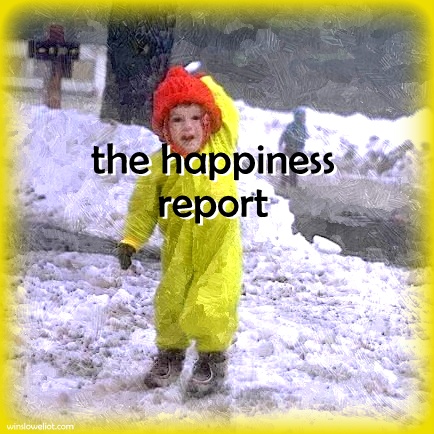 Every year there’s a global ‘happiness’ report that’s put out, and this year is no exception. Countries like Finland (winner again), Denmark, Switzerland, Iceland, and Norway continue to rate highest on the happiness scale. People in these countries may not smile as frequently as Americans do, but they express solidity and confidence in each other, their communities, and their governments. They take for granted that helping others is essential for everyone’s success and well-being. The United States continues to plummet on the happiness scale. Americans continue to have a basic mistrust of government, strangers, and even of happiness. In order to be happy or successful, they think that someone else has to be unhappy or unsuccessful, and they’d rather it weren’t them. There’s been a longstanding movement to take happiness more seriously in the United States, since a lack of happiness ripples out in ways that aren’t easily measurable, like anxiety and stress. There’s not just a viral epidemic spiraling out of control, but an anxiety epidemic, especially among young people. What if, instead of prescribing medication, our educationists taught happiness? What if our government made it natural that it could be trusted (by not lying, for example, or by not taking advantage of power)? What if children were shown how they could have confidence in a safe and happy future? In the United States educational testing is based on competition and stress—what if we instead tested for creativity, imagination, invention, hopefulness, and service-oriented work? What if we tested for happiness? As I mull in solitude through these challenging times, I’m still seeing all sorts of good things happening around the world. We don’t live in a world of fear—it’s a world of courage and love. Teaching happiness, especially to children, actually teaches courage and love. When the dust settles, it seems to me a good way forward.
Every year there’s a global ‘happiness’ report that’s put out, and this year is no exception. Countries like Finland (winner again), Denmark, Switzerland, Iceland, and Norway continue to rate highest on the happiness scale. People in these countries may not smile as frequently as Americans do, but they express solidity and confidence in each other, their communities, and their governments. They take for granted that helping others is essential for everyone’s success and well-being. The United States continues to plummet on the happiness scale. Americans continue to have a basic mistrust of government, strangers, and even of happiness. In order to be happy or successful, they think that someone else has to be unhappy or unsuccessful, and they’d rather it weren’t them. There’s been a longstanding movement to take happiness more seriously in the United States, since a lack of happiness ripples out in ways that aren’t easily measurable, like anxiety and stress. There’s not just a viral epidemic spiraling out of control, but an anxiety epidemic, especially among young people. What if, instead of prescribing medication, our educationists taught happiness? What if our government made it natural that it could be trusted (by not lying, for example, or by not taking advantage of power)? What if children were shown how they could have confidence in a safe and happy future? In the United States educational testing is based on competition and stress—what if we instead tested for creativity, imagination, invention, hopefulness, and service-oriented work? What if we tested for happiness? As I mull in solitude through these challenging times, I’m still seeing all sorts of good things happening around the world. We don’t live in a world of fear—it’s a world of courage and love. Teaching happiness, especially to children, actually teaches courage and love. When the dust settles, it seems to me a good way forward.
PS: Here’s a link to the NYT article on the Happiness Project.
